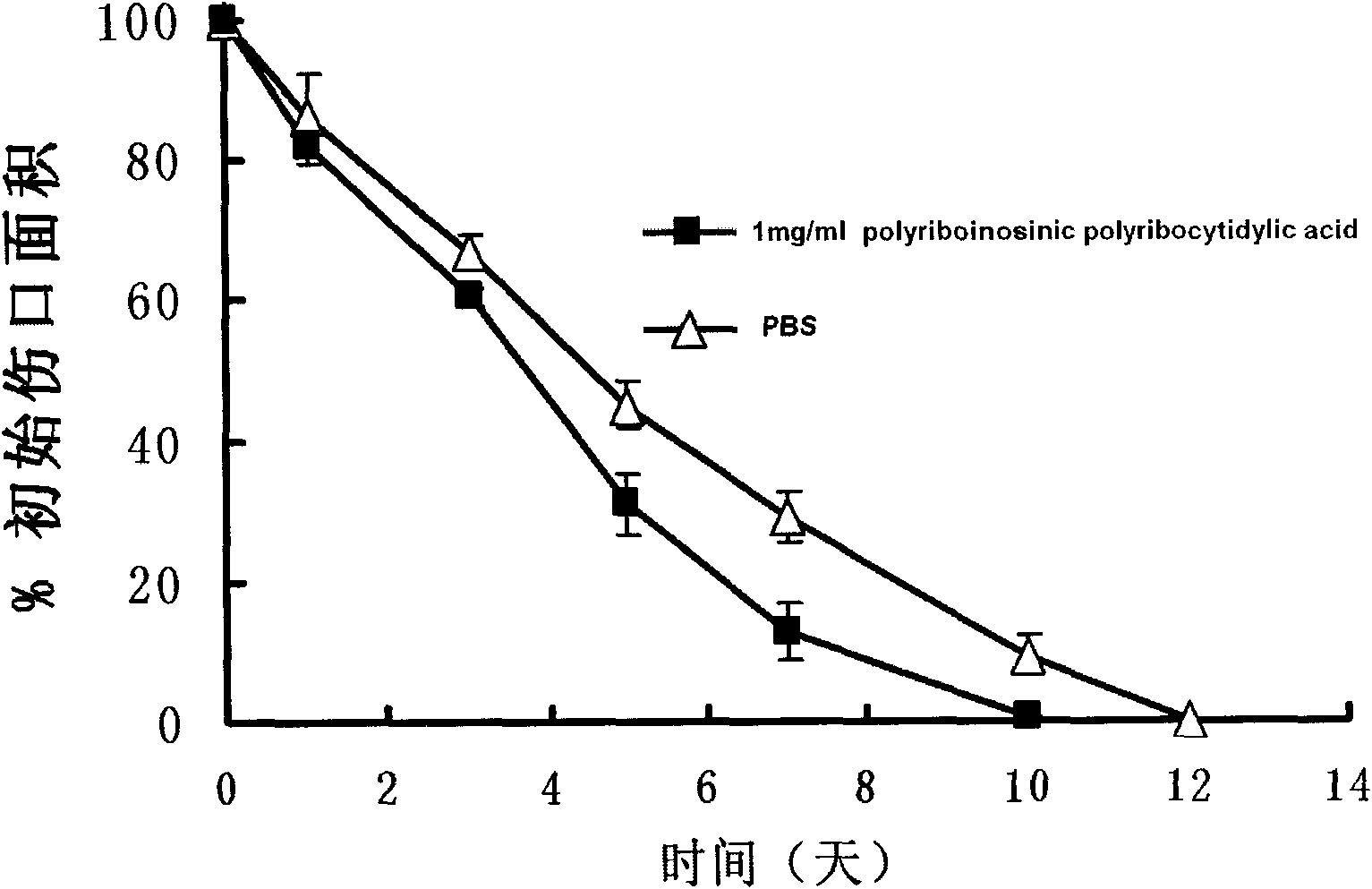Application of Toll-link receptor-3 agonist to preparation of medicines for promoting wound healing
A technology of wound healing and agonist, applied in the biological field, can solve the problems of excessive scar hyperplasia and healing quality, affecting the healing effect of growth factors, cholesteatoma and cell malignant transformation, so as to promote wound healing, high quality of wound healing, and promote healing effect
- Summary
- Abstract
- Description
- Claims
- Application Information
AI Technical Summary
Problems solved by technology
Method used
Image
Examples
Embodiment 1
[0036] The healthy C57BL / 6 mice with surgical wounds treated according to the above method were randomly assigned to different treatment groups, with 6 mice in each group, and the researchers could not distinguish them during the whole observation process. After the operation, 20 μl of 1 mg / ml polyriboinosinic polyribocytidylic acid solution was topically applied to the two wound surfaces on the left side of the midline of the back skin of each experimental mouse with a pipette every day. The same volume of control pure PBS solution was applied, and treated according to this method until the wound was completely healed. On the day after the operation and on the 1st, 3rd, 5th, 7th, 10th, 12th, and 14th days after the operation, microscopic electronic photos of the wound were collected, and then the wound area was quantified by using Adobe PhotoShop (version 7.0; Adobe Systems) software, and each wound area was healed The extent is expressed as a percentage relative to the initi...
Embodiment 2
[0044] The healthy C57BL / 6 mice with surgical wounds and the TLR3 knockout C57BL / 6 mice with surgical wounds treated by the above method were observed for natural wound healing process every day after operation.
[0045] The TLR3 knockout C57BL / 6 mice treated according to the above method and formed surgical wounds were randomly assigned to different treatment groups, with 6 mice in each group, and the researchers could not distinguish them during the entire observation process. After the operation, 20 μl of 1 mg / ml polyriboinosinic polyribocytidylic acid solution was topically applied to the two wound surfaces on the left side of the midline of the back skin of each experimental mouse with a pipette every day, and the edge of the pipette was used to spread the drug to the entire wound, while the two wounds on the right The wound was treated with the same volume of control pure PBS solution, and treated according to this method until the wound was completely healed.
[0046] O...
Embodiment 3
[0056] Outpatients with pigmented spots were randomly divided into two groups according to the order of their visits. One group of patients received topical 1 mg / ml polyriboinosinic polyribocytidylic acid injection once a day on the wound after laser speckle removal, and the other group received ordinary Physiological saline injection was used as a control, and aureomycin ointment was applied to the wounds of patients in this group at other times of the day to promote healing.
[0057] Such as Figure 7 As shown, the results of clinical experiments show that compared with the control group (p<0.01, n=9) of routine clinical medication (chlortetracycline ointment), local use of polyriboinosinic polyribocytidylic acid injection with a specification of 1mg / ml can effectively promote wound healing. heal. As shown in Table 1, polyriboinosinic polyribocytidylic acid can significantly reduce the complete healing time of postoperative wounds in patients. The average clinical routine m...
PUM
| Property | Measurement | Unit |
|---|---|---|
| Diameter | aaaaa | aaaaa |
Abstract
Description
Claims
Application Information
 Login to View More
Login to View More - R&D Engineer
- R&D Manager
- IP Professional
- Industry Leading Data Capabilities
- Powerful AI technology
- Patent DNA Extraction
Browse by: Latest US Patents, China's latest patents, Technical Efficacy Thesaurus, Application Domain, Technology Topic, Popular Technical Reports.
© 2024 PatSnap. All rights reserved.Legal|Privacy policy|Modern Slavery Act Transparency Statement|Sitemap|About US| Contact US: help@patsnap.com










